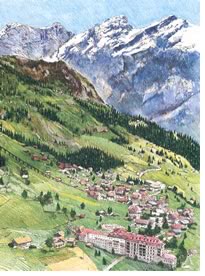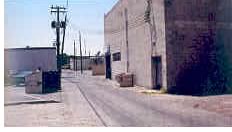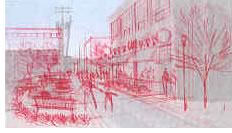
by Jim Leggitt, AIA
RNL Design
 At
the end of each chapter throughout the beautifully illustrated text of
Jim Leggitt's new Drawing Shortcuts
book, published by John Wiley & Sons, are checklists of "QuickTips"
pertaining to particular styles of drawing and drawing tools. Presented
here is only one tip from each section. There are many, many more-but
you'll have to buy the book if you want them (and you will!).
At
the end of each chapter throughout the beautifully illustrated text of
Jim Leggitt's new Drawing Shortcuts
book, published by John Wiley & Sons, are checklists of "QuickTips"
pertaining to particular styles of drawing and drawing tools. Presented
here is only one tip from each section. There are many, many more-but
you'll have to buy the book if you want them (and you will!).
 Thumbnail
drawing:
Thumbnail
drawing:
Create the thumbnail at twice the size you want it to be. Reduce the drawing
50% on a copier for a final reproduction.
Concept drawing:
Don't hesitate to add wildlife to your drawing to help animate areas that
otherwise would appear lifeless. Flying birds, geese on water, squirrels
in grass, and dogs on a leash are good examples.
Perspective drawing:
If you're drawing a bridge-level perspective of a building, try not to
establish your horizon line much higher than the parapet line. Any higher
and you'll begin to show too much of the parapet roof.
 Paraline
drawing:
Paraline
drawing:
Isometric drawings rely so much on 30-degree angles that it's a good idea
to purchase a drafting triangle with a 30- and 60-degree angles. It is
much quicker to draw with a preset angle.
Imagination drawing:
Add humor to your drawing. Don't be afraid to exaggerate key elements
of the image. The benefit of making drawings from your imagination is
that they don't have to be realistically accurate.
Direct observation
drawing:
Tilt your drawing board up so that you can work with your face square
to the paper. If the board is flat and you're looking at it from a severe
angle, the image may strech out of proportion.
Projected image drawing:
It's much easier to draw from a projected image on a horizontal surface
(table top) than a vertical surface (wall). Unless you are projecting
a very large image, try to project onto a horizontal surface. Drawing
on a wall surface can exhaust your arms.
 Overlay
and tracing:
Overlay
and tracing:
If you're tracing an image or a photograph, and it's difficult to see
all the detail through your drawing paper, work on a light table. The
detail will be much easier to see. An easy makeshift light table is a
piece of glass propped up on books with a desk lamp place beneath the
glass.
Cameras:
If you can vary your camera's exposure settings, it's better to use a
higher f-stop (f22), which increases the depth of filed and ensures that
a larger area will be in focus.
 Copiers:
Copiers:
Research the different types of papers you can use for making copies.
Color copiers use a much brighter and higher grade than the duller papers
used in standard copiers. You can purchase a ream of high-quality paper
and use it for all your copying work.
Computers:
Save all computer wireframes and renderings to use for future reference
and presentation.
 Drawing
tools:
Drawing
tools:
When coloring with markers, always apply your lightest colors first and
gradually build the colors to the darkest makers. Reversing the order
will cause the dark colors to smear.
Color drawing:
It may not be necessary to color every square inch of your drawing. Be
selective and you can save a lot of time by highlighting only the most
important information with color.
Copyright 2002 The American Institute of Architects. All rights reserved.
![]()
|
You can order a copy of Drawing Shortcuts from the AIA Bookstore: $40.50 AIA members/$45 retail(plus $6 shipping per order). Phone 800-242-3837 option #4, fax 202-626-7519, or send an email. To read a review of Drawing Shortcuts, click here |
|